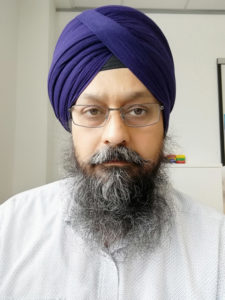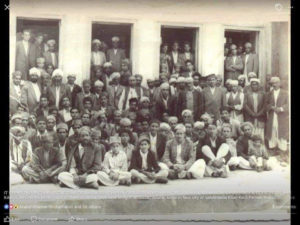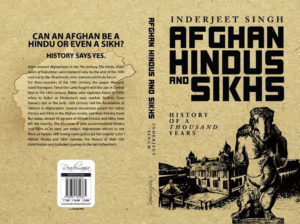“Afghanistan is a dangerous place to live in but minorities are more vulnerable”
It is wrong to assume that Hindus and Sikhs are recent migrants to Afghanistan. Diwan Niranjan Das, an Afghan Hindu, negortiatedindependence of Afghanistan with the British government in India in 1920.

Inderjeet Singh is the author of the recently published ‘Afghan Hindus and Sikhs: A History of a Thousand Years’. In the wake of the March 25th 2020 attacks on the 400 years old Guru Har Rai Sahib Gurdwara in Kabul, IAR spoke to him on the history and future of the Hindu and Sikh community of Afghanistan.
Can you tell us how Sikhs came to be in Afghanistan? And what is their ethnicity? Are they originally from the Punjab or are they ethnic Pathans/Tajiks/Hazaras?
An Afghan manuscript Hudud Al Alam compiled in 982-83 CE puts a number of regions in Eastern Afghanistan, like Laghman and Parwan provinces, as part of Hindustan (India). It mentions [the existence] a number of idol temples in various cities of Afghanistan, including [in] Kandahar and Kabul. It was around this time that the Hindu Shahi dynasty lost Kabul to the Turkic ruler Sabuktigin, father of Mahmud Ghaznavi. It is wrong to assume that Hindus totally vanished from Afghanistan at that point and Hindus and Sikhs are recent migrants to the country.

Guru Nanak visited Afghanistan in 1521 and the some of the Hindus who were living there become his followers or Nanakpanthis. Later his son, Sri Chand who started the Udasi sect also visited Afghanistan in 1540. Guru Amardas (1552-74) established number of missionary seats known as Manjis and one of them was in Kabul. Sikh chroniclers record the visit of Sikhs from Kabul and Afghanistan to Punjab during the 17th and 18th centuries. Hence, we have historical Gurdwaras in Kabul, Sultanpur, Jalalabad, Kandahar and other cities. In terms of gotras, the Sikhs and Hindus of Afghanistan are mostly Khatris and Aroras.
Are there more Sikhs than Hindus today in Afghanistan, and if yes, why?
There are about 800-850 Sikhs and about 50-60 Hindus in Afghanistan. More than half are in Kabul and rest are in Jalalabad and Ghazni. Some other cities do have Sikhs and Hindus, but they are likely only a handful of about 4 to 8 persons, with families shifted to India.
The Soviet invasion of the country in 1979 led to a resistance supported by the USA, Pakistan and other countries. The Soviets left Afghanistan in 1989 and in the next 2-3 years the Mujahedeen who fought the Soviets were able to capture the country. About ninety per cent of Afghan Sikhs and almost all Hindus left Afghanistan in 1992 just before the Mujahedeen captured the last bastion, Kabul from Dr Najibullah’s government. At that juncture, Dr Najibullah informed the Indian government that he was unable to protect the Sikhs and Hindus. The Indian embassy in Kabul issued them speedy visas even as Kabul city was being bombed by the Mujahedeen. Both the governments showed urgency and 2-3 people (and in some cases even 4 people) were given visas on one passport.
What were Sikh-Afghan relations like, before the Soviet invasion of Afghanistan?
Before 1992, relations between the Afghan and the Sikh and Hindu communities were good. Diwan Niranjan Das, an Afghan Hindu, was the Minister of Finance and Commerce under Amir Amanullah Khan (1919-29). He is particularly remembered for negotiating the independence of Afghanistan with the British government in India in 1920. Subsequently there has been a Sikh MP in Afghanistan till date including Jai Singh Faani who was directly elected as an independent candidate in 1969.

The Afghan government recognised economic contribution that the Sikhs and Hindus had made in Afghanistan local [Afghans] treated them very well. People trusted them with their money more than they did the banks. Most of them were into money lending, local banking, or owned businesses.
Let me share an incident. In 1954, the local government decided to widen the road and Gurdwara Guru Nanak Darbar at Jalalabad came under that modernisation plan. This meant that the gurdwara had to be demolished and the local government would give land [for the gurdwara] elsewhere. When the Sikhs failed to convince the local authorities not to demolish the gurdwara, a petition was made to the Emperor Zahir Shah in Kabul who issued a royal edict and the gurdwara was handed back to the Sikhs. The road widening plan was changed. After 1960s Afghan Hindus and Sikhs took more interest in modern education. I personally know doctors from amongst the Afghan Hindu and Sikh community. Dr Joginder Singh Tej Khurana who is former member of the Afghan Grand Assembly (1990-92) is writing biographies of about 40 doctors/physicians among the community.
However, 40 years of civil war has made the community bitter. Some Afghans have also become [religiously] more fundamentalist but even today an Indian gets a nice welcome in Afghanistan.
What is the current economical and political status of the Sikhs in Afghanistan today? Are they economically strong? Politically powerful?
The 40 years of civil war have made Afghans bitter and, in some cases, more fundamentalist. Sikhs boys are bullied in school and at times Sikhs are taunted and asked to convert but others are fine. Many of the houses of Sikhs had been illegally captured by warlords and powerful neighbours during the Mujahideen era.
The current regime of President Ashraf Ghani is sympathetic to Sikhs and has allotted 5 million Afghanis for repair of gurdwaras and temples. The government is currently renovating the premises of Gurdwara Guru Nanak Darbar in Jalalabad, but no government has done anything to free the illegal occupation of the houses of Afghan Sikhs in Kabul.
Narinder Pal Singh Khalsa is the nominated member of the Afghan Parliament and his brother is the Adviser to the President. They are doing their best under difficult circumstances. More than 10,000 civilians have been killed each year in the past five years. In 2019, half of the civilian casualties were due to attacks by the Taliban and they were fellow Sunni Muslims, killed to gain negotiating power with the Americans.Afghanistan is a dangerous place to live in but minorities are more vulnerable.
Why do you think this specific attack by IS-K took place? Do you think Pakistan is behind it? What could be the motivation?
In some quarters India has also been blamed but we must look at the wider picture to understand the situation. ISKP (Islamic State – Khorasan Province)/Daesh has claimed the responsibility for the attack. ISIS has declared an unofficial war against Shias in Afghanistan. Their places of worship, weddings, tuition centre, and gatherings have been targeted numerous times over the past five years. Sikhs are also infidels in their eyes. This is a continuation of their war on infidels. The whole world knows their carnage of Yezidis in Iraq.
Do all or most Sikhs from Afghanistan want to migrate from Afghanistan?
I cannot speak for all 850 people, but the Indian Express [recently] reported that they have made a petition to the Indian Embassy in Kabul and to the Indian Government through Delhi Gurdwara Management Committee. Some prefer to migrate to a western country like Canada as it is easier to build a future there, even from scratch. However, as it seems less likely now, many them want to come to India purely from a security angle. There are anumber of widows who have never stepped outside their houses which is on the gurdwara premises in most cases. It will be very difficult for them to work and earn enough to live on.
What should India do?
Afghan Sikhs and Hindus who want to come to India should be evacuated and the same kind of urgency which was  demonstrated in 1992 [by both governments] is required. And then they should be given citizenship quickly.
demonstrated in 1992 [by both governments] is required. And then they should be given citizenship quickly.